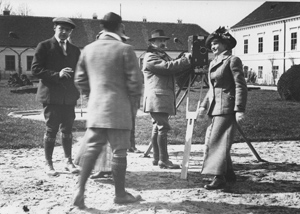Eduard Schreiber
 Schreiber (holding the camera) filming The Kidnapping, Lednické Rovne, 1910. | |
| Born |
May 25, 1876 Vienna, Austria-Hungary |
|---|---|
| Died |
January 17, 1962 (aged 85) Schönaich, near Württemberg, Germany |
Eduard Schreiber was an early amateur filmmaker. His documentary sketches and feature film belong to the oldest preserved films (1907-10) made in the area of Slovakia.
Life and work[edit]
Schreiber was born in 1876 to Josef Schreiber jr. (8.3.1835–17.11.1902[1]) from Charváty (today Dub nad Moravou, Czech Republic) and Theresia Gerhardt (1842–1932) from Palčice. Uncle of his father (Josef Schreiber sr., ?–1878) was an entrepreneur, since 1857 specialising in establishing glassworks in various places in Austria-Hungary, Russia and Germany. In 1865 he resigned from the company and handed part of his business to his nephew, Joseph Schreiber jr.[2][3][4] The firm grew rapidly and sold worldwide, primarily to Britain and America. In 1890 Josef Schreiber jr. bought a large noble estate in Lednické Rovne (then Lednicróna), near Púchov, Kingdom of Hungary (today Slovakia), along with a huge beech forest. Two years later he launched a glassworks there which soon became one of the most modern in Europe.[5][6][7][8][9] He was substantial in developing the village infrastructure including a school, notary (with its own new building), telegraph office, doctor, workers colony (Uhrovec), factory food association and inn.[10] In 1890 he built a Neo-Renaissance mausoleum in the park in which he was later buried.[11] The estate with mansion and park was inherited by his four sons, Max, Eduard, Alfréd and Rupert.[12]
Schreiber attended agricultural school where he learnt photographing and machine construction, including that of steam locomotives. He built one of his miniature locomotives in Lednické Rovne and used it to ride his brothers and friends on the rails he laid in the mansion park. He used his photo glass disc apparatus to continuously document the fields, forests, and technical inventions.[13]
In 1896 he began working at the estate of his father and modernized it introducing new technological methods in work in forest as well as on field. Lednické Rovne got telephone connection, their own electricity, steam-sawpills, ploughs. He supported cultural and social life in the village. He loved literature, especially Rilke's poems and essays, later he began translating Byron and Shakespeare's sonnets, and directed Shakespearean comedies. He was often heard playing Bach's fugues in the church.
Schreiber first encountered cinematograph on one of his visits in Vienna at the turn of the centuries. He began filming in June 1907, documenting a procession in Lednické Rovne [Procesia v Lednici]. Next year he bought 16-mm camera Pathé Fréres No. 1101 and projector with arc lamp from the firm R.Lechner in Vienna. Over two years he made 50+ film sketches documenting his family, life on the farm, agriculture, technics, new machines, inventions, but also more on music, literature, theatre, art, philosophy, sociology and sport, screening them to his family and workers from the estate and glassworks. Some fo them were preserved (through the initiative of film historian Ivan Rumanovský who entered into contact with Schreiber in the 1950s), such as Ladies and a Dog [Dámy a pes], Golf [Golf], Summer on Váh [Leto na Váhu], Skying [Lyžovanie], Mimicry of Frida Schreiber [Mimika Frídy Schreiberovej], Modernization of Sawpill [Modernizácia píly], Loading the Cattle [Nakladanie dobytka], New Automobile [Nové auto], Steam-plowing [Parné oranie], Work on Sawmill [Práca na píle], Cutting the Ice [Rúbanie ľadu], Donkey farm in Lednické Rovne [Selárne v Lednických Rovniach], Harvest [Žatva]. Preserved fragments suggest a refined sense for composition and ability to build up and narrate a story.
In 1910 Schreiber made the short feature film The Kidnapping [Únos] from which several scenes have been preserved. The film is a parody on then popular cowboy films, in which three friends attempt to heal a zealous detective story female reader (Schreiber's niece Fritzi, Frederika Schuller) from her passion by her scripted abduction. The film featured Frederika's friends from Vienna, Július Chini (author of original story and script), Marta Brunner, and Alexander Brunner. Filming lasted three days and took place in the park of the family. After finishing this film, Schreiber quit filming.
In 1945, Schreibers were forced to exile in West Germany (except for his brother Rupert Otto who moved to Nové Mesto nad Váhom), their estate was nationalised and mansion was turned into a grammar school. The glassworks are still in operation, while mansion partially serves as a glass museum.[14] Schreiber's camera was kept by Miloš Jurkovič until it was acquired by the National Technical Museum in Prague.[15]
Literature[edit]
- Tkáč, František (1964). "Spojené sklárne v Lednických Rovniach". Vlastivedný časopis (Pamiatky a múzeá) 13 (3): 144 (Slovak). [16]
- Vraštiak, Štefan (1971). "Eduard Schreiber". Výtvarníctvo Fotografia Film 9: 156-157 (Slovak).